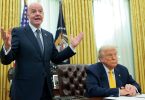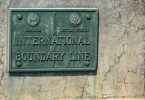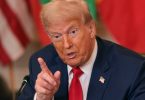Tuesday, May 13, 2025
US President Donald Trump secures more than six hundred billion USD Saudi investment deal in a historic Riyadh visit. This massive move by US President Donald Trump reshapes GCC and American aviation, tourism, and business ties in the midst of a trade war. As US President Donald Trump touched down in Riyadh, the red carpet was rolled out, signaling not just diplomacy—but the sealing of more than six hundred billion USD in Saudi investment. The visit by US President Donald Trump wasn’t just symbolic. It carried deep economic weight as more than six hundred billion USD flowed through defense, energy, technology, and especially aviation, tourism, and business.
This historic Riyadh visit marks a powerful turning point. While the world watches the ongoing trade war, US President Donald Trump shifts the narrative with a game-changing investment deal. The more than six hundred billion USD Saudi investment shakes the foundations of GCC and American ties. It pulls aviation, tourism, and business into a new orbit. US President Donald Trump used this Riyadh visit to rewrite regional alliances and amplify American travel and business interests.
Moreover, this historic Riyadh visit sends ripple effects across GCC and American tourism sectors. The more than six hundred billion USD will fuel new projects, flight routes, hospitality infrastructure, and cross-border ventures. Even in the heat of the trade war, US President Donald Trump pushes forward, turning conflict into commerce. The Riyadh visit, the six hundred billion USD Saudi investment, and the reshaping of GCC–American aviation and tourism now define a new era.
In a high-stakes diplomatic and economic tour through the Gulf, U.S. President Donald Trump has secured a groundbreaking $600 billion investment commitment from Saudi Arabia. This deal, anchored in sectors like defense, energy, infrastructure, and travel, marks one of the most ambitious financial alliances between the U.S. and Saudi Arabia in recent memory.
The historic agreement unfolded in Riyadh, where Trump was welcomed with royal grandeur. The Saudi investment pledge, part of a broader initiative to deepen bilateral cooperation, includes what officials call the largest defense sale in U.S. history, totaling nearly $142 billion. But beyond weapons and oil, this agreement signals a seismic shift in how tourism, travel infrastructure, and cross-border business will evolve between the U.S. and the Gulf.
As Air Force One touched down in Riyadh, the symbolism was unmistakable. Trump, flanked by American CEOs including Elon Musk, made it clear: this visit was about business. It was about revitalizing U.S.–Gulf economic diplomacy. And it was about transforming how both regions interact across every major travel and tourism vertical.
The implications for the global travel industry are enormous.
With Riyadh set to boost spending in the U.S., major hospitality, aviation, and tourism brands are poised to benefit. Experts anticipate a surge in hotel partnerships, airport upgrades, and destination investments between both countries. Moreover, Gulf carriers and U.S. airlines may accelerate codeshare deals and route expansions, particularly with a focus on luxury, business-class travel, and medical tourism.
Meanwhile, travel infrastructure in Saudi Arabia is also expected to see vast improvements, bolstered by U.S. technology, design, and management expertise. As part of Vision 2030, the Kingdom is already rolling out giga-projects like NEOM and Red Sea Global, which aim to attract millions of international tourists annually. With this new capital alliance, U.S. firms are likely to claim a larger stake in developing these destinations.
However, the absence of a stop in Israel has raised diplomatic eyebrows. Trump’s decision to skip his country’s closest Middle Eastern ally during this tour has sparked speculation. Analysts suggest the focus of this Gulf-centric visit may be part of a broader realignment—prioritizing commercial alliances and investments over traditional geopolitical engagements.
On Wednesday, Trump will head to Qatar and then to the United Arab Emirates on Thursday. Both nations are major players in regional aviation, hospitality, and tourism. Qatar Airways and Emirates have dominated international aviation headlines in recent years, and deeper U.S. cooperation could lead to enhanced regulatory frameworks, open skies discussions, and collaborative ventures in aviation tech.
Moreover, this U.S.–Saudi investment pact might ignite a new tourism corridor between the West and the Gulf. With the United States increasingly looking eastward for partnerships and Gulf nations pushing to diversify away from oil, travel becomes the connective tissue. Increased direct flights, joint marketing campaigns, visa facilitation policies, and cultural exchange initiatives may follow.
Airports in cities like Los Angeles, New York, Riyadh, Jeddah, and Dubai are expected to see a rise in high-value traffic. Luxury travelers, entrepreneurs, and cross-border investors will demand upgraded lounges, faster immigration protocols, and more exclusive travel experiences.
For the business travel sector, this deal is a game-changer. Multinational corporations operating in aerospace, hospitality, defense, and real estate are now realigning their Gulf strategies. Travel management companies and corporate travel planners are recalculating routes and adjusting itineraries to accommodate this wave of economic diplomacy.
The hospitality industry, in particular, is bracing for impact. American hotel brands with a presence in Saudi Arabia—including Marriott, Hilton, and Hyatt—stand to benefit immensely. New development agreements, co-branded resorts, and executive hospitality experiences are expected to emerge. In return, Saudi sovereign wealth funds may inject capital into U.S. tourism assets, from coastal resorts in Florida to ski lodges in Colorado.
Furthermore, this deal adds momentum to Gulf region efforts to position themselves as global tourism and business hubs. Saudi Arabia’s ongoing tourism transformation, Qatar’s post-World Cup branding, and the UAE’s futuristic travel offerings align with the vision Trump’s administration is pushing: strong bilateral partnerships anchored in commerce and travel.
However, this historic deal also comes with geopolitical risk. As Saudi Arabia strengthens its economic ties with the U.S., tensions with regional rivals could flare. Future travelers, airline operators, and hospitality players will have to navigate complex diplomatic dynamics as they build services and experiences across a shifting regional map.
In essence, this $600 billion investment commitment is not just about defense or oil. It’s about the future of international travel, economic mobility, and tourism diplomacy. It signals the beginning of a new era—where investment drives influence, and where the skies between the U.S. and the Gulf may become the busiest, most valuable corridors in global aviation.
The red carpet welcome in Riyadh wasn’t just ceremonial. It marked a shift in how countries engage, how travel shapes foreign policy, and how tourism can anchor trillion-dollar strategies.
As Trump continues his Gulf tour, the eyes of the travel world remain fixed on what happens next.
Tags: Abu Dhabi, and Business Ties, California, Doha, Dubai, florida, gulf states, Israel, Jeddah, Los Angeles, Mecca, Medina, Middle East, Nevada, New Jersey, New York, QATAR, Reshaping GCC and American Aviation, Riyadh, saudi arabia, Tel Aviv, Texas, Tourism, United Arab Emirates, United States, US President Donald Trump Secures More Than Six Hundred Billion USD Saudi Investment Deal in Historic Riyadh Visit in the Midst of Trade War, Washington D.C., What Travel Industry Need to Know











